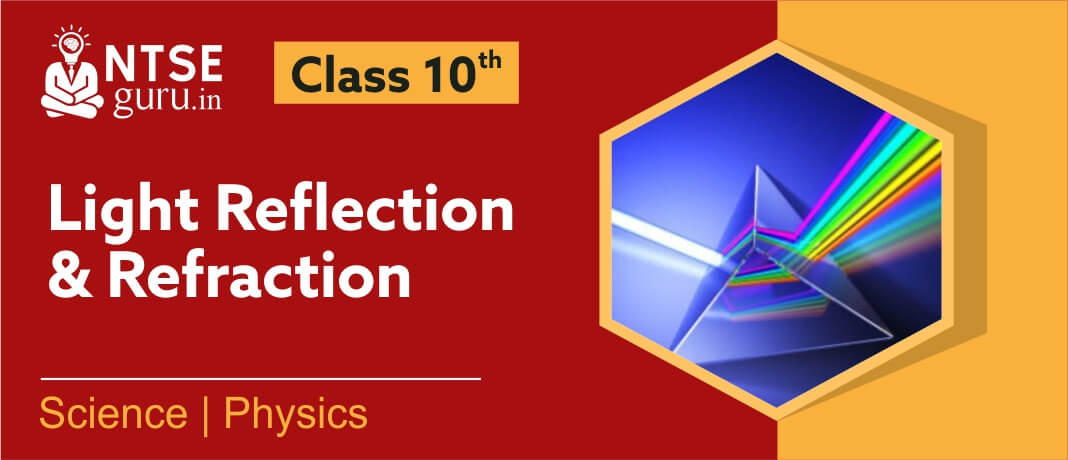Electricity Class 10 Science Chapter 12
Do you want help to Score well in Exams? You are here on this page means you are looking for something to help you study a...


Class 10 Science Chapter 10 in NCERT Science deals with Light: Reflection & Refraction. The chapter includes important concepts about How are we able to see the world, Phenomena of Reflection and Refraction of Light, Refractive Index, Spherical Mirrors and propagation of Light and various relations between them. It also includes important practical topics like Spherical Lenses, Power of Lens and how to calculate themand their application in real life situations are included in the chapter.
1. What do you mean by:
a) Reflection b) Scattering of light?
Ans. a) Reflection: The phenomenon of bouncing back of the light rays from any surface into the same medium is called reflection
Here, m m’ represents reflecting surface.
AO represents incident ray.
OB represents reflected ray.
ON represents normal at the point of incident (o)
\(\angle i\) represents angle of incidence.
\(\angle r\) represents angle of reflection.
b) Scattering: In scattering, light is intercepted by an object and sent off in many directions; this movement may appear to be random and is called scattering.
2. What is a spherical mirror? Explain different types of spherical mirrors.
A portion of reflecting surface, which forms part of a hollow sphere is termed as spherical mirror.
Types of spherical mirrors:
a. Concave mirror: A spherical mirror whose reflecting surface is towards the centre of the hollow sphere of which the mirror is a part, is known as concave mirror.
b. Convex mirror: A spherical mirror whose reflecting surface is away from the centre of the hollow sphere of which the mirror is a part, is known as convex mirror.
3. Define the following terms for a spherical mirror:
(a) Pole (b) Centre of curvature
(c) Radius of curvature (d) Principal axis
(e) Principal focus (f) Focal length
(g) Aperture
a) Pole: Pole is the midpoint or centre of the spherical mirror. It is usually represented by the letter ‘P’.
b) Centre of curvature: It is the center of that sphere of which the mirror is a part. Generally it is represented by the letter ‘C’.
c) Radius of curvature: It is the radius of the sphere of which the mirror is a part. It is represented by the letter ‘R’.
d) Principal axis: It is the line joining the pole and the centre of curvature of the mirror.
e) Principal focus: It is the point on the principal axis where parallel rays after reflection either actually meet or appear to meet. It is also simply called focus. It is represented by the letter ‘F’.
f) Focal length: It is the distance between pole and focus along the principal axis. Focal length is half of the radius of curvature. It is represented by letter f.
g) Aperture: In reference to a mirror, it means the effective diameter of the light reflecting area of the mirror.
4. a) State uses of convex and concave mirror.
b) What changes can we observe if we use plane mirror in place of convex mirror as a rear–view mirror in a vehicle?
Ans. a) Uses of convex and concave mirror are as follows.
Uses of convex mirror:
Uses of concave mirror:
b) If we use plane mirror as a rear–view mirror in a vehicle then, we cannot get a wider field of view of the traffic on the back side.

5. a) What is magnification? What information does it carry?
b) Can magnification be negative for a convex mirror? If not, why?
c) When does a concave mirror produce negative & positive magnification?
Ans. a) It is the ratio of the size of the image formed to the size of the object. It is represented by ‘m’.
\(\text{m}\,\text{=}\frac{\text{size of the image (I) }}{\text{size of the object (O) }}\)
We can also calculate the magnification in terms of object distance and image distance. It is equal to the ratio of the image distance (v) to the object distance (u) with a negative sign.
\(\therefore m=-\frac{v}{u}\)
If ‘m’ is – ve, image formed is inverted.
If ‘m’ is + ve, image formed is erect.
m = 1, size of image = size of object
m< 1, image is diminished (smaller than the object ).
m> 1, image is magnified (larger than the object ).
No. The magnification in case of a convex mirror is always positive because image formed is always virtual and erect.
\(Mathematically, \text{magnification }=-\frac{\text{image}\,\,\text{distance }}{\text{object}\,\,\text{distance }}\)
Let, object distance = – y,
Image distance (for virtual image) \(=+\text{x}\) (According to sign convention)
\(\therefore m=-\left( \frac{+x}{-y} \right)=+\frac{x}{y}\)
c) A concave mirror produces negative magnification when image formed by it is real & produces positive magnification when image formed is virtual.
NTSEGuru helps you to boost your preparation with the most probable questions in accordance with the revised pattern of X board examination by our expert team of faculties.
Have a great time learning with us!
Electricity Class 10 Science Chapter 12
Do you want help to Score well in Exams? You are here on this page means you are looking for something to help you study a...